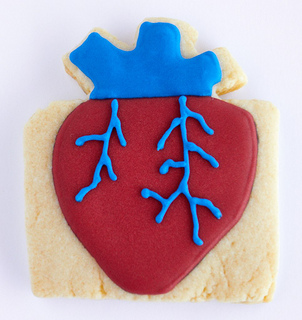« Prev Next »
 Heart attack is one dramatic example for how scar tissue is harmful to your health. When someone has a heart attack, some of their heart muscles die from the sudden lack of oxygenated blood. If the person survives the initial attack, those dead patches are a serious liability because they cannot withstand the forces generated by the still-pumping heart and may simply rip apart. Fortunately, dead cells stimulate an inflammatory response, which in turn signals fibroblasts to migrate quickly to the dead patches in order to maintain the heart's structure integrity and keep it pumping. Just in case you're not a cell biologist, fibroblasts are scaffolding cells that other cell types grow on top of. They hold your organs in place and give them their shape, and they help your wounds heal. In fact, scar tissues are composed of mostly fibroblasts, which is precisely what happens in the heart after a heart attack. The scar tissue in the heart decreases its blood-pumping ability, which generally worsens over time.
Heart attack is one dramatic example for how scar tissue is harmful to your health. When someone has a heart attack, some of their heart muscles die from the sudden lack of oxygenated blood. If the person survives the initial attack, those dead patches are a serious liability because they cannot withstand the forces generated by the still-pumping heart and may simply rip apart. Fortunately, dead cells stimulate an inflammatory response, which in turn signals fibroblasts to migrate quickly to the dead patches in order to maintain the heart's structure integrity and keep it pumping. Just in case you're not a cell biologist, fibroblasts are scaffolding cells that other cell types grow on top of. They hold your organs in place and give them their shape, and they help your wounds heal. In fact, scar tissues are composed of mostly fibroblasts, which is precisely what happens in the heart after a heart attack. The scar tissue in the heart decreases its blood-pumping ability, which generally worsens over time.
Researchers have been focusing on making heart muscle cells from pluripotent cells (ESCs and iPSCs) specifically to replace scar tissues in a damaged heart. Conventional methods like directed differentiation rely on multi- or pluri-potent cells as a key transition point. That is until 2010, when Ieda M et al.1 showed that it may be possible to change fibroblast cells directly into heart muscle cells without a pluripotent cell intermediate and brought the term "transdifferentiation" to the forefront of cellular reprogramming. Transdifferentiation is the latest chapter in the study of cellular reprogramming and refers to the transformation of one somatic cell type into another without a multi- or pluri-potent cell intermediate. Skepticism abounds regarding the validity of such studies because most biologists think it's an experimental artifact. But if it turns out to be a real phenomenon, it may make therapies based on ESCs and iPSCs obsolete. More importantly, transdifferentiation solidifies the idea that manipulating just 3 or 4 genes are all that's needed to control regeneration, and that scar tissues may be converted to functional tissues.
A new technical breakthrough was reported this past week that suggested exactly that. Jayawardena TM et al.2 modulated the essential genes described in Ieda's paper using microRNA (miRNA) technology, which works by controlling RNA turnover. MiRNA is much easier to work with in culture, and doesn't have the same mutagenic risks associated with traditional virus-based methods. What's especially neat about Jayawardena's study is that when miRNAs (encoded in a virus particle-yeah, they didn't inject the miRNAs directly) were injected into the hearts of mice that just suffered a heart attack, there was less scarring in those hearts and the fibroblast cells turned into new heart muscle cells. They were able to show this by genetically tagging fibroblast cells in the heart and tracking those cells for the appearance of heart muscle markers after miRNA injections. It is the genetic tagging that gives this study its punch because it was able to show the new heart cells were derived from fibroblasts rather than from local stem cells. But I still wonder if the scar formation process itself may alter regeneration, and if preventing fibroblasts from forming scar tissues is enough to stimulate heart muscle cell growth. And what if inflammation is suppressed? Would that decrease the number of fibroblasts in the heart and stall regeneration?
There are certainly a few follow-up questions worth asking for this study alone. There are also more general questions we may consider. If we think about it, the main reason for continuing research in reprogramming or pluripotent cells is to find new ways to grow replacement parts for patients, and to do so safely, cheaply, and quickly. It's too soon to say which method would be best for patients. First of all, nobody knows which method would generate cells that are fully matured and functional. So far, the laboratory methods used to ascertain cell identity and function in such studies are not comprehensive. Secondly, the therapeutic effects of these engineered cells have shown only temporary improvement and there are not enough data from long-term studies to be informative. Personally, even if the transdifferentiation can be better defined and its mechanisms are understood, I'm still skeptical about its utility because of the reductionist view researchers tend to take. I question if transdifferentating one cell type into another would cause damage because the process upsets a broader homeostasis. How can we effectively monitor the transdifferentiation process and build a kill-switch in the system to prevent undue side effects? Would a new branch of study or healthcare management spring up to meet such a need? That'll give the word "micromanagement" a whole new meaning.
Image credit: IFeelCook (via Flickr) http://www.flickr.com/photos/ifeelcook/6957923848/
Further reading:
Graf T. Historical Origins of Transdifferentiation and Reprogramming Cell Stem Cell 9, 504-516 (2011).
References:
- Ieda M et al. Direct reprogramming of fibroblasts into functional cardiomyocytes by defined factors. Cell 142, 375-386 (2010).
- Jayawardena TM et al. MicroRNA-Mediated In Vitro and In Vivo Direct Reprogramming of Cardiac Fibroblasts to Cardiomyocytes. Circ Res 2012 Apr 26. [Epub ahead of print] doi: 10.1161/CIRCRESAHA.112.269035






















